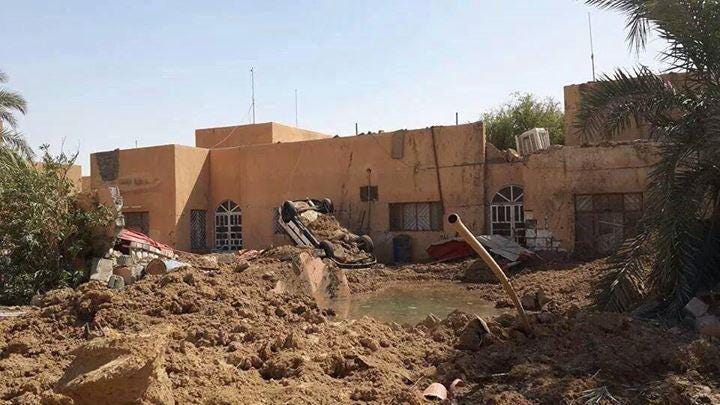Iranian air force F-14. Photo via the author
The Syrian and Iranian Air Forces Are Now Bombing Iraq
There are four air arms flying over the embattled country
On the morning of June 24, unidentified jet fighters bombed a market in the Islamist-held city of Al Qa’im in northwestern Iraq. The city, which recently fell to militants from the Islamic State of Iraq and Syria, is near the Syrian border, so we’re assuming the bombers were Syrian—an eastward extension of Damascus’ brutal air war against rebel forces.
At approximately the same time as the market exploded, Iraqi social media users reported contrails over Baghdad heading from west to the east. The contrails didn’t match the usual twin pattern of civilian airliners or military cargo aircraft, indicating fighters.
Four separate air arms are now active over Iraq, which is fighting a desperate battle against invading ISIS militants coming from Syria. Iraq, Syria and—possibly—Iran have bombed ISIS. And the U.S. Navy and Air Force are flying reconnaissance missions.
We’re pretty sure the contrails over Baghdad weren’t from American planes. Since around June 18, U.S. Navy F/A-18s flying from the aircraft carrier USS George H.W. Bush in the Persian Gulf have been keeping tabs on the militants’ advance from Syria into Iraq’s interior.
It seems likely the F/A-18s and other American planes are taking the southeastern route around Baghdad in order to avoid heavily-populated areas.
 Bomb damage in Baiji. Photo via the author
Bomb damage in Baiji. Photo via the author
It appears Iran joined the air war on June 21. That’s the day that someone launched heavy air strikes on the city of Baiji, north of Baghdad. ISIS invaded Baiji in an apparent attempt to seize the city’s huge oil refinery.
A photo that circulated in the attack’s aftermath depicted a deep crater that appears to be bigger than any of Iraq’s warplanes could have inflicted. Iraq’s air arms possess helicopters and lightweight propeller-driven planes whose biggest weapons are 100-pound Hellfire missiles.
Iran’s air force, on the other hand, possesses plenty of heavy weaponry—and high-performance jet fighters to deliver it.
Furthermore, eye witnesses to the Baiji raid claimed the attackers were fighters rather than helicopters or light planes.
 Contrails over Baghdad. Photos via Iraqi social media
Contrails over Baghdad. Photos via Iraqi social media
Situated just 130 miles directly north of Baghdad, Baiji is a bit far into Iraq for Syria’s warplanes to hit, considering the western concentration of Damascus’ forces and the Bashar Al Assad regime’s lack of aerial refueling tankers.
But isn’t too far for Iran, which has a more extensive network of air basesand can deploy 707 and 747 tankers.
The Iranian air force possesses around 80 F-4 and Su-24 bombers as well as F-14 interceptors modified for ground strikes. Hundreds of less capable warplanes including F-5s, Mirages and MiG-29s back up the main fighter-bombers. Tehran’s engineers have developed a range of TV- and laser-guided bombs as large as 2,000 pounds.
Iran can also deploy armed long-range drones such as the Shahed-129, which can conduct surveillance missions to spot targets in advance of attacks by manned planes.
The Iranian air force has been on high alert since ISIS invaded Iraq in early June and, shortly thereafter, also struck an Iranian border post. Iraq’s air arms have sustained heavy losses in their desperate attempts to block ISIS’ movement toward Baghdad.
The evidence points to limited Iranian raids in Iraq. Whether this escalates depends on ISIS’ battlefield fortunes—and whether the militants directly attack Iran again.
Medium has an app! Sign up for a daily War is Boring email update here. Subscribe to WIB’s RSS feed here and follow the main page here.
No comments:
Post a Comment